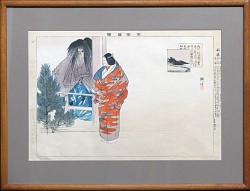
By Eva Allan
We had an unforeseeably long time to live with a print from the GALC; we checked it out more than a year ago, pre-lockdown, and then it became our COVID companion artwork. A Japanese print by Kogyo Tsukioka, Funabashi: The Floating Bridge, it depicts a scene from traditional Noh theater. The plot of the play, as described by the writing on the print, involves lovers separated first by a river and then by death–their disapproving families removed part of the bridge and the man drowned, becoming a lingering spirit searching for rest in the afterlife.
In this scene, the actor playing the woman stands just to the left of the center of the print, by the edge of the doorway or big window. On the other side of the jamb, the actor playing the man-spirit stands behind some railings of a bridge. We can see neither his feet nor the surface on which he stands, which helps us understand the supernatural nature of the “floating bridge.” A pine tree, also with an indeterminate base, appears on the left, also obscuring the supports of the bridge. The pine, long-lived and evergreen, could symbolize remembrance, longevity, and steadfast, undying love (as it does elsewhere in Japanese literature).
One of the pleasures of viewing original artwork is enjoying details you can’t easily appreciate in reproduction. With just a few lines, Tsukioka indicates the sag of organic skin under the painted wooden masks. We see the ribbon that ties the woman’s mask behind the actor’s head. The masks and costumes contribute to the theatrical nature of the characters: the man wears a jacket with enormous grey sleeves and a wide-legged blue pants; his mask is exaggeratedly masculine under an enormous wig; his outfit boasts large-scale patterns with big bamboo leaves and twisting black birds, but with subtle grey and blue colors. The fabric of the woman character’s kimono features a delicate, repeating floral pattern, with heart-shaped leaves like a domestic begonia or violet. Long, abstract narrow ribbons and lapping waves pattern her kimono, wrapping around the actor like fingers, and echo the grasp of her hand that holds in the heavy fabric (in the absence of a belt/obi). This fabric may make her character seem more demure and confined, but her kimono features a prominent red-orange fabric, the strongest color of the print, and she is placed just off center, which contributes to the tension felt between the two tragically separated characters.
We hung this print next to our own impression of the Nihonbashi Bridge in Snow by Hiroshige, which my husband bought when he visited Japan for a conference as a graduate student. The prominent bridge in the Hiroshige emphasized the small bridge depicted by Tsukioka, but the juxtaposition brought out many more differences between the prints. The Nihonbashi Bridge was more about everyday people going about daily errands and the busy world of commerce; because of the snow but also because of their tasks they keep their heads down and hurry towards their purposes. The Funibashi: Floating Bridge scene exists outside of the daily rush, outside even of worldly time, in a fantastic, theatrical setting.
Then, the COVID crisis meant that we all entered a stay-at-home lockdown. During this strange time, the Floating Bridge print took on new layers of meaning: the man and woman seemed to be on opposite sides of a big pane of glass, paralleling our own separation from the world. The Hiroshige print, with its bustle, business, and commercial activity, suddenly became cold and unrelatable, as we stopped running errands or hurrying to school and work. We stayed inside, looking out of the window or at a computer screen; our days merged into a timeless otherworldliness. The characters in the Floating Bridge scene became closer to the daily images on the news: they were like the musicians on balconies in Italy, encouraging healthcare workers; like the teddy bears placed in the windows to delight children on neighborhood walks; or the rainbows drawn by children and taped on windows to symbolize hope in the midst of the COVID-crisis. The separated lovers came to resemble nursing home residents and their visitors, separated by glass windows, unable to embrace.
Too soon, the Floating Bridge print became a reminder of the deaths of so many loved ones, now hundreds of thousands on the other side of the bridge of mortality. So many COVID victims had to say goodbye to their families separated by glass or by screens, wearing masks or otherworldly ventilators and oxygen tubes, barred and blockaded from corporal human touch.
In the end, there is that little pine. Both figures in the Floating Bridge scene turn towards it, rather than making eye contact with each other. It isn’t tall, just a bushy sapling really. Tsukioka allows it to come into the woman’s space, although it seems more likely to be growing outside next to the bridge, as in a Japanese garden. This modest pine becomes the symbol of life beyond human lifespan, of hope that the coronavirus wouldn’t keep us separated from our families forever, and of love that could last beyond mortality.
Thank you for allowing us to keep this print during the lockdown time, for waiving late fees and extending due dates. The extra time offered more moments of spontaneous insight. It encouraged long looking in a year when much of our attention was given to the distraction of computer screens. It was extraordinary to live with an original artwork that seemed to gather new harrowing meaning in this unusual and difficult year, and I’m grateful for the extra time we had with this print.